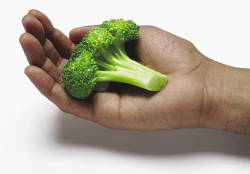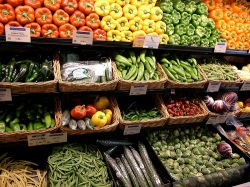
Health benefits of eating broccoli (Photo: Wikimedia)
Maybe Mum was right after all, you should really eat your veggies. If she tried with Brussels sprouts you might instead go for broccoli. I’ll soon tell you why.
Broccoli is now a common part of the diet in many countries, but it is a fairly recent addition to most of the world. Not so in Italy where it has been considered a uniquely valuable food since the Roman Empire. The word broccoli is actually the plural form of the Italian broccolo. Broccoli consumption was slowly introduced to other countries in Europe during the 18th century, and has been available in the USA for less than 100 years.
Broccoli is a plant in the cabbage family. It has large flower heads, usually green in color, arranged in a tree-like structure on branches sprouting from a thick, edible stalk. Broccoli is high in vitamin C, dietary fibre and contains multiple nutrients that are suggested to have considerable health benefits. Broccoli is usually boiled or steamed but may also be eaten raw. Some of the nutrients are destroyed by boiling in particular, while steaming, microwaving or even stir frying might retain most of the proposed health activities.
Before getting in to all the proposed health benefits of consuming broccoli, a word of warning. While a single serving from one head could include enough health benefits to keep you going for a few days, another head might do nothing. Researchers have found that the nutritional content of broccoli tends to fluctuate wildly. Environment and plant genetics appear to affect the composition of broccoli. And you have no way of knowing by looking at the flower head.
Lucky you
But let’s assume you are lucky. You could then get high levels of antioxidants like carotenoids, tocopherols, ascorbic acid and flavonoids that inhibit free radical reactions in the body, reducing oxidative damage and promoting cardiac health. The carotenoids lutein and zeaxanthin also have been associated with a reduced risk of macular degeneration. Glucosinolates called glucoraphanin and glucobrassicin protect against cancer. DIM (3,3′-diindolylmethane if you care for the details), a chemical produced from another compound present in broccoli when it is chewed and digested, might be able to boost DNA repair in cells and appears to block the growth of certain cancer cells. Studies at the University of California, Berkeley, have shown that DIM halts the division of breast cancer cells and inhibits testosterone, the male hormone needed for growth of prostate cancer cells. DIM is also expected to be a potent modulator of the immune response system with anti-viral and anti-bacterial activities.
What more could you ask for? Well, before getting widely enthusiastic there is still some further caveats. Recent studies suggest that the effect of broccoli and related cruciferous vegetables on cancer risk may partly depend on an inherited variation in certain metabolic enzymes. Here we have a double whammy. First you have to be lucky in your choice of broccoli, but as that is not enough you also need to have the right genetic expression. Further, although laboratory and animal studies have suggested that certain compounds in broccoli may have anti-cancer properties, they do not provide proof that such effects can be achieved in humans. More studies are needed to find out whether possible anti-cancer properties could benefit humans.
Maybe not that simple
Some scientists caution that while broccoli appears promising as an excellent food for preventing cancer, the results of such studies cannot be considered by themselves. The anti-cancer effects of any single food cannot be completely understood without looking at it as part of a bigger dietary picture. It is still unclear, for example, whether the special nutrients in broccoli have benefit on their own or whether it is the vitamin C, beta carotene, folate, and other compounds, working together and in the right quantities, that might protect people against cancer.
But there are glimmers of hope on the horizon, at least in relation to the consistency of broccoli composition. Field trials and genetic studies have shown that a new variety of broccoli reliably yields higher levels of a health-promoting compound. A long term breeding programme to increase glucoraphanin levels resulted in the commercial release of Beneforté broccoli in the UK in 2011. Beneforté broccoli consistently produces 2-3 times the amount of glucoraphanin than other leading varieties of broccoli, without affecting yield, quality or the levels of other nutrients. Glucoraphanin contains sulphur, which broccoli derives from the soil. Beneforté increases the amount of sulphur it takes up from the soil, and also channels more of it into glucoraphanin.
So no excuse for not eating broccoli now as future research might show that you made the right choice.
Related articles
- Reliably higher levels of healthy compound in Beneforte broccoli (eurekalert.org)
- Compound in Broccoli Kills Leukemia Cancer Cells, Leaves Healthy Cells Unaffacted (myscienceacademy.org)
- Are you eating your Broccoli? (deesfitness.co.uk)
- foods_broccoli_large_tcm4-532832.jpg (ilovebeetroot.wordpress.com)
- Benefits of Broccoli (hollyleehealth.wordpress.com)
- Broccoli – The Beauty Food (lifesalittlenutrition.wordpress.com)


Reblogged this on The Naked Cavewoman and commented:
Yummy broccoli! Here’s some more information about this SUPER Food.
What about Brussels sprouts? If likeable I will give them a go as well.
Brussel Sprouts are yum too! But I must admit I can’t eat very many as they, um, tend to make me gassey 🙂
Hey dad are we having broccoli tonight?
No time for shopping today so no. Will try tomorrow. Glad I managed to convince you of the benefits.